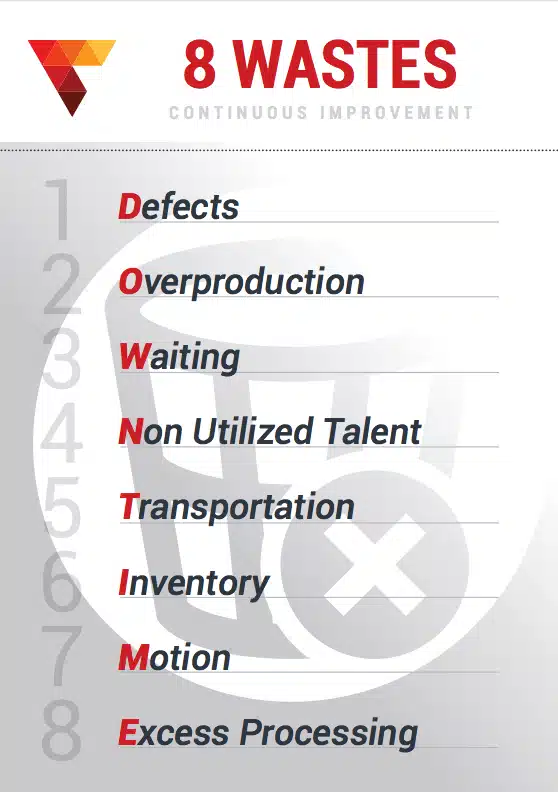Cut Waste. Improve Flow. Get Lean. Learn how to eliminate the 8 deadly wastes that hurt your bottom line.
This article delves into the 8 Wastes of Lean, a framework used to identify and eliminate unnecessary activities that add no value to a product or service. Whether you’re a seasoned professional or just starting your Lean journey, understanding these wastes can empower you to streamline processes, reduce costs, and improve overall performance. Let’s explore each waste in detail and discuss strategies for eliminating them from your organization.
Main Takeaways from This Article
- The 8 Wastes of Lean are common inefficiencies that can hinder organizational performance.
- Identifying and eliminating these wastes can lead to improved productivity, reduced costs, and enhanced customer satisfaction.
- The 8 Wastes are: Overproduction, Waiting, Transport, Processing, Inventory, Motion, Defects, and Underutilized Talent.
- Strategies for eliminating wastes include: 5S, Value Stream Mapping, Kanban, and Kaizen.
- By focusing on eliminating waste, organizations can create a more efficient and effective operating environment.
What is Waste?
Waste can take many forms, but the basic idea is to eliminate anything and everything that does not add value from the perspective of your customer. In other words, eliminate everything that your customer is unwilling to pay for in order to own your product or service.
Do you have customers that are willing to pay to repair manufacturing machines? For extra inventory? For the steps and the time that a worker takes to move the product from one machine to the next machine? Didn’t think so. Neither do we.
In order to improve efficiency, effectiveness, and profitability, you must focus relentlessly on eliminating all aspects of the manufacturing process that add no value from your customer’s perspective.
Waste is any step or action in a process that’s not required to complete a process (called “Non Value-Adding”) successfully.
When Waste is removed, only the steps that are required (called “Value-Adding”) to deliver a satisfactory product or service to the customer remain in the process.
“We cannot become what we want to be by remaining what we are.” —Max DePree
See What A Full Continuous Improvement System Looks Like
What are the 8 wastes of Lean?
The Lean manufacturing model categorizes waste into eight key types that can be found within an organization. By understanding and addressing these wastes, businesses can streamline their processes, reduce costs, and improve overall efficiency.
To remember the 8 Wastes, you can use the acronym, “DOWNTIME”:
D Defects
O Over production
W Waiting
N Non-Utilized Talent
T Transportation
I Inventory
M Motion
E Extra-Processing
Minimize the 8 Wastes in your Continuous Improvement Projects.
1. DEFECTS
Defects impact time, money, resources and customer satisfaction. They’re products or services that are out of specification which require resources to correct. This typically results in either reworking or scrapping the product. Both results are wasteful as they add additional costs to the operations without delivering any value to the customer.
Defects can manifest themselves in different ways, but the reason they occur often stems from the fact that there was a failure to implement steps to catch and correct human error.
Specific defect causes include:
- Poor quality control at the production level.
- Poor machine repair.
- Lack of proper documentation.
- Lack of process standards.
- Not understanding your customers’ needs.
- Inaccurate inventory levels
Countermeasures for Defects:
- Design processes so they are less likely to produce defects.
- Design processes to detect abnormalities so they can be immediately corrected.
- Look for the single most frequent defect and determine why it occurs.
- Create work instructions that provide a consistent method of manufacturing the part.
“If you define the problem correctly, you almost have the solution.” —Steve Jobs
2. OVERPRODUCTION
Overproduction occurs when manufacturing a product or an element of the product before it’s being asked for or required. Overproduction can create several negative effects.
While it might be tempting to produce as many products as possible, this tactic, the “Just in Case” way, causes a host of problems. This strategy can prevent smooth workflow, drive up storage costs, and hide defects in the inventory among others.
In an office environment, overproduction could include making extra copies, creating reports no one reads, providing more information than needed, and providing a service before the customer is ready.
Rather than a “Just in Case” strategy, Lean methodologies believe businesses are better off subscribing to the “Just in Time” concept of production. This production philosophy focuses on customer demand instead of producing as much product as possible, and allows your company to operate more efficiently.
Common causes of overproduction include:
- Unreliable process.
- Unstable production schedules.
- Inaccurate forecast and demand information.
- Customer needs are not clear.
- Poor automation.
- Long or delayed set-up times.
Countermeasures for overproduction?
- Pace production so the rate of manufacturing matches the rate of customer demand.
- Use a pull system to control how much is manufactured.
- Reduce setup times so that smaller batches can be economically manufactured.
“Great things are done by a series of small things brought together.” —Vincent Van Gogh
3. WAITING
In many ways, waiting is the opposite of overproduction. Waiting is perhaps the easiest of manufacturing wastes to overlook. The waste of waiting includes people waiting on material or equipment and idle equipment. Waiting time is often caused by unevenness in the production stations and can result in excess inventory and overproduction.
In an office setting, a good example of waiting is unnecessary or excessive meetings, long email chains, long queue of files waiting to be approved, and more.
Common causes of waiting include:
- Unplanned downtime or Idle equipment.
- Long or delayed set-up times.
- Poor process communication.
- Lack of process control.
- Producing to a forecast.
- Idle equipment.
What are countermeasures for waiting?
- Design processes so that the flow is continuous and there are minimal (or no) buffers between steps in production.
- Use standardized work instructions to ensure that a consistent method and consistent times are used for each step of production.
Track The Impact Of Your Lean Projects
4. NON-UTILIZED TALENT
The elimination of this type of waste can improve all others. This type of manufacturing waste occurs when management in a manufacturing environment fails to ensure that all their potential employee talent is being utilized. When workers are given the opportunity to thrive in the workplace, they work their hardest and best.
By engaging employees and incorporating their ideas, providing training and growth opportunities and involving them in the creation of process improvements that reflect the reality they experience and the skills they possess, overall operational effectiveness is improved.
In the office, non-utilized talent could include insufficient training, poor incentives, not asking for employee feedback, and placing employees in positions below their skills and qualifications.
In manufacturing, this waste can be seen when employees are poorly trained, employees not knowing how to effectively operate equipment, when employees are given the wrong tool for the job, and when employees are not challenged to come up with ideas to improve the work.
Causes of non-utilized talent:
- Poor communication.
- Failure to involve people in workplace design and development.
- Lack of or inappropriate policies.
- Incomplete measures.
- Poor management.
- Lack of team training.
Countermeasure for non-utilized talent:
- Skill Assessment
- Training and Development
- Job Rotation
- Mentorship Programs
- Career Development Plans
- Open Communication
“However beautiful the strategy, you should occasionally look at the results.” —Winston Churchill
5. TRANSPORTATION
Waste in transportation includes movement of people, tools, inventory, equipment, or products further than necessary. Excessive movement of materials can lead to product damage and defects. Additionally, excessive movement of people and equipment can lead to unnecessary work, greater wear and tear, safety issues, and exhaustion.
In the office, workers who collaborate with each other often should be close together. In the factory, materials necessary for production should be easily accessible at the production location and double or triple handling of materials should be avoided.
Common types of transportation waste include:
- Poor layouts – large distance between operations.
- Long material handling systems.
- Large batch sizes.
- Multiple storage facilities.
- Poorly designed production systems.
Countermeasures for transportation waste:
- Take a Gemba walk, paying especially close attention to the steps involved in production.
- Redesign processes, focusing on ways to minimize movement and streamline manufacturing.
- Design a linear, sequential flow from raw materials to finished goods.
See How Eliminating The 8 Wastes Could Impact Your Bottom Line.
6. INVENTORY
Often times it is difficult to think about excess inventory as waste. In accounting, inventory is seen as an asset and oftentimes suppliers give discounts for bulk purchases. But having more inventory than necessary to sustain a steady flow of work can lead to problems.
Excess inventory prevents detecting production-related problems since defects have time to accumulate before it is discovered. As a result, more work will be needed to correct the defects.
In-office inventory waste could be files waiting to be worked on, customers waiting for service, unused records in a database, or obsolete files. Manufacturing inventory waste could include broken machines sitting around, more finished products than demanded, extra materials taking up work space, and finished products that cannot be sold.
Countermeasures for Inventory Waste:
- Bring raw materials in only as they are needed and only in the quantity needed.
- Reduce or eliminate buffers between steps in production.
- Refer to Overproduction countermeasures.
“Lean is about constant ticking, not occasional kicking.” —Alex Miller
7. MOTION
Motion costs money. The waste in motion includes any unnecessary movement of people, equipment, or machinery. This includes walking, lifting, reaching, bending, stretching, and moving. Tasks that require excessive motion should be redesigned to enhance the work of personnel and increase the health and safety levels.
In the office, wasted motion can include walking, reaching to get materials, searching for files, sifting through inventory to find what is needed, excess mouse clicks, and double entry of data.
Manufacturing motion waste can include repetitive movements that do not add value to the customer, reaching for materials, walking to get a tool or materials, and readjusting a component after it has been installed.
Common motion waste examples include:
- Poor workstation layout.
- Poor production planning.
- Poor process design.
- Shared equipment and machines.
- Siloed operations.
- Lack of production standards.
Countermeasures for motion:
- Ensure that work areas are logically organized.
- Consider alternate arrangements of equipment that reduce motion.
“Lean thinking defines value as providing benefit to the customer, anything else is waste.” —Eric Ries
8. EXTRA PROCESSING
Extra processing refers to the concept of adding more features or producing a product or service of higher quality than required by the customer.
One simple way to counter extra processing is to understand the work requirements from the standpoint of the customer. Always have a customer in mind before starting work, produce to the level of quality and expectation that the customer desires, and make only the quantities needed.
Examples of excess processing include:
- Poor communication.
- Not understanding your customers’ needs.
- Human error.
- Slow approval process or excessive reporting.
Countermeasures for extra processing:
- Better understanding of your customer’s product expectations.
- Have customer expectations in mind before designing production processes.
- Produce to the quality level customer desires/needs.
Continuously Improve With Our Latest News & Updates
Identifying and Eliminating the 8 Wastes from Your Production Process
The ability to streamline processes, reduce costs, and improve quality is essential for staying competitive. One effective approach to achieving these goals is by identifying and eliminating the 8 Wastes. In this section, we discuss practical steps for eliminating them from your production process.
1. Acknowledge the Presence of Waste
The first step to reducing waste is recognizing that they exist and having an effective process for identifying them. In order to identify wastes, start with the end customer in mind. Work backwards from the end customer to the start of the production processes.
2. Start with the End Customer in Mind
Clearly articulate your customers’ needs and expectations for your product or service. This includes factors such as quality, delivery time, and cost. By keeping the customer at the center of your waste elimination efforts, you can ensure that your initiatives are aligned with their needs and deliver the maximum value.
3. Identify Waste in Each Process
Employ tools such as value stream mapping, 5S, and the 7 Wastes to systematically identify and visualize waste within your processes. Spend time on the shop floor, observing the flow of work and identifying areas where delays, inefficiencies, or defects occur. Involve employees who are directly involved in the processes to gain their insights and identify potential areas for improvement.
4. Engage Frontline Workers
To effectively identify and eliminate the 8 wastes from your production process, it’s crucial to involve frontline workers. Their firsthand knowledge of daily operations provides invaluable insights. Implement a collaborative approach where teams brainstorm and share ideas. Use tools like value stream mapping to visualize the entire process and pinpoint areas of waste. Encourage workers to suggest improvements, no matter how small.
5. Develop a Plan for Waste Elimination
To effectively eliminate waste, develop a comprehensive plan that outlines specific goals and action steps. Begin by conducting a thorough waste audit to identify the types and sources of waste within your operations. Prioritize areas with the highest potential for improvement. Implement lean manufacturing principles to streamline processes and reduce waste. Regularly monitor progress and make necessary adjustments to ensure continuous improvement.
6. Challenge your team for continuous improvement
Challenge your team for continuos improvent by fostering a culture of innovation and open communication. Encourage them to think critically about processes and identify areas for improvement. Provide opportunities for training and development to enhance their skills and knowledge. Recognize and reward their contributions to drive a sense of ownership and motivation.
Streamline Lean Process Improvement with KPI Fire
By focusing on eliminating waste, such as defects, overproduction, waiting, transportation, inventory, motion, processing, and underutilized talent, lean manufacturing helps businesses to reduce costs, improve quality and increase efficiency. In this regard, KPI Fire can significantly streamline the process of tracking and managing waste elimination within an organization.
Its balanced scorecard benefits include a comprehensive framework for monitoring and improving performance across various dimensions. KPI Fire Balanced Scorecard Software enables you to measure performance from multiple perspectives, including financial, customer, internal processes, and learning and growth.
Overall, KPI Fire’s balanced scorecard features offer a valuable tool for organizations seeking to effectively track and manage waste elimination. By providing a comprehensive framework, or single source of truth for project management, KPI Fire can help you achieve your waste reduction goals and drive overall organizational performance.
Are you ready to take your organization to new heights by eliminating waste and optimizing your processes? Schedule a personalized demo of KPI Fire Operational Excellence Software today and experience firsthand how our balanced scorecard features can help you achieve your goals.





